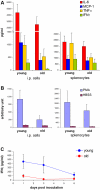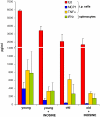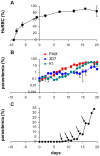Further improvements of the P. falciparum humanized mouse model
- PMID: 21483851
- PMCID: PMC3069031
- DOI: 10.1371/journal.pone.0018045
Further improvements of the P. falciparum humanized mouse model
Abstract
Background: It has been shown previously that it is possible to obtain growth of Plasmodium falciparum in human erythrocytes grafted in mice lacking adaptive immune responses by controlling, to a certain extent, innate defences with liposomes containing clodronate (clo-lip). However, the reproducibility of those models is limited, with only a proportion of animals supporting longstanding parasitemia, due to strong inflammation induced by P. falciparum. Optimisation of the model is much needed for the study of new anti-malarial drugs, drug combinations, and candidate vaccines.
Materials/methods: We investigated the possibility of improving previous models by employing the intravenous route (IV) for delivery of both human erythrocytes (huRBC) and P. falciparum, instead of the intraperitoneal route (IP), by testing various immunosuppressive drugs that might help to control innate mouse defences, and by exploring the potential benefits of using immunodeficient mice with additional genetic defects, such as those with IL-2Rγ deficiency (NSG mice).
Results: We demonstrate here the role of aging, of inosine and of the IL-2 receptor γ mutation in controlling P. falciparum induced inflammation. IV delivery of huRBC and P. falciparum in clo-lip treated NSG mice led to successful infection in 100% of inoculated mice, rapid rise of parasitemia to high levels (up to 40%), long-lasting parasitemia, and consistent results from mouse-to-mouse. Characteristics were closer to human infection than in previous models, with evidence of synchronisation, partial sequestration, and receptivity to various P. falciparum strains without preliminary adaptation. However, results show that a major IL-12p70 inflammatory response remains prevalent.
Conclusion: The combination of the NSG mouse, clodronate loaded liposomes, and IV delivery of huRBC has produced a reliable and more relevant model that better meets the needs of Malaria research.
Conflict of interest statement
Figures






References
-
- Druilhe P, Hagan P, Rook GA. The importance of models of infection in the study of disease resistance. Trends Microbiol. 2002;10:S38–46. - PubMed
-
- Druilhe P, Barnwell JW. Pre-erythrocytic stage malaria vaccines: time for a change in path. Curr Opin Microbiol. 2007;10:371–378. - PubMed
-
- Dondorp AM, Yeung S, White L, Nguon C, Day NP, et al. Artemisinin resistance: current status and scenarios for containment. Nat Rev Microbiol. 2010;8:272–280. - PubMed
-
- Shanks GD. Treatment of falciparum malaria in the age of drug resistance. J Postgrad Med. 2006;52:277–280. - PubMed
Publication types
MeSH terms
Substances
LinkOut - more resources
Full Text Sources
Other Literature Sources

